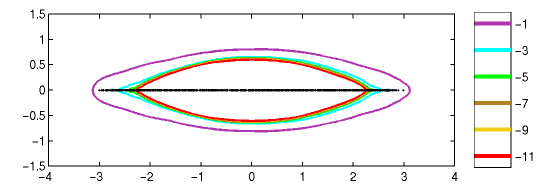Pseudospectra of a Non-Hermitian Anderson Model
Dimension N=1000

This example of a Non-Hermitian Anderson model is a tridiagonal matrix
with has exp(0.4) on the first super-diagonal,
exp(-0.4) on the first sub-diagonal, and
random entries uniformly distributed between [-1.5,1.5] on
the main diagonal.
This type of model was first suggested by N. Hatano and D. R. Nelson,
"Localization transitions in non-Hermitian quantum mechanics",
Phys. Rev. Lett. 77 (1996), 570-573.
Pseudospectra of a related random bidiagonal model are analyzed in
[TCE01].
Further details about this example can be found on the page:
Pseudospectra of Random Matrices: The Non-Hermitian Anderson Model.
Use the following MATLAB code compute a similar image using
EigTool.
To mimic the example above, set N=1000 below.
N = 100;
g = 0.4;
A = exp(-g)*diag(ones(N-1,1),-1) + ...
diag(3*rand(N,1)-1.5) + ...
exp(g)*diag(ones(N-1,1),1);
opts.npts = 20;
opts.ax = [-4 4 -1.5 1.5];
opts.levels = [-11:-1];
eigtool(A, opts)
Download this code: randand.m.
|

